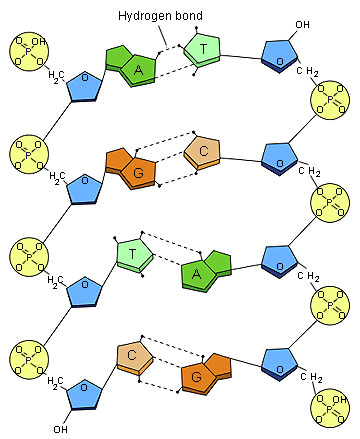
How do genes work? As discussed earlier genes are located on chromosomes and consist of DNA. How does a cell use genes composed of DNA to carry on its functions and create replica cells? How does a DNA molecule replicate itself? For you to answer these questions you will need to learn the chemical make-up of the two nucleic acids - DNA and RNA. In miniunit Alpha you learned that nucleic acids are polymers of nucleotides and that nucleotides are made up of three subunits - phosphates, five carbon sugars, nitrogen bases. Read the pages indicated by D-10 in the text and study behavioral objectives 25-31.
Fill in the table below comparing nucleotides which make up DNA and
RNA. Study the figures showing the chemical makeup of these nucleotides
located on the pages indicated by D-11.
Place this table in your notes.
| \\\\\\\\\ | Phosphate present | Five Carbon Sugar present | Nitrogenous Bases present |
| DNA |
|
||
| RNA |
|
1. Click here to check answer. click
Note: RNA is different from DNA in that RNA contains the sugar ribose in place of deoxyribose and DNA contains the bases Adenine, Thymine, Cytosine, Guanine and RNA contains the bases Adenine, Cytosine, Guanine, and Uracil in place of Thymine.
The nitrogen containing bases can be classified as follows:
Fill in the following table.
| /////////////////////////// | PURINES | PYRIMIDINES |
| Bases | ||
| Bases |
2. Click here to check answer. click
3. Which of the bases consist of a double ring? single ring?
Click here to check answer. click
DNA molecules consist of two polymers of nucleotides (double stranded) held together by weak hydrogen bonds between complementary base pairs in the form of a helix (examine figure in readings showing a double stranded DNA). Complementary base pairs are specific "A" will always be attracted to "T" and "C" will be attracted to "G" for DNA. Note: one of the complementary pair is a purine and the other is a pyrimidine. Study the figure below and place in your notes.
DNA
4. What complementary base will be attracted to adenine "A" in RNA?
Click here to check answer. click
P - D - P - D - P - D - P - D
|
| |
|
A
C C
T
T
G G
A
|
| |
|
P - D - P - D - P - D - P - D
5. Identify what the letters above represent and the type of bonding
which holds these molecular units together.
Click here to check answer. click
This figure resembles a ladder with the uprights consisting of of phosphates
and sugars and the rungs of the ladder nitrogen bases. If this ladder
was twisted to form a spiral stair case than it would resemble the helical
nature of DNA.
DNA
Note. RNA is not double stranded; however, it may fold back on itself and become attached see example on pp 202 of the text. This represents a tRNA.
6. What would the complementary strand of a DNA polynucleotide with
the following bases?
ATTAGGCCAATCGCG
Click here to check answer. click
7. Identify the following arrangement of base as DNA or RNA.
AAGGCGCUAUCG
Click here to check answer. click
8. Identify the following polynucleotide as DNA or RNA.
A G
G A
| |
| |
P - R - P - R - P - R - P - R
Click here to check answer. click
This is the end of lesson seven. In the next lesson you will
learn how genes work at a molecular level. This process will involve DNA
being translated into mRNA which in turn will direct the synthesis of proteins
that may take the form of enzymes which cause specific chemical reactions
producing a phenotype. Click here to go back to the home page and
lesson eight, Gene Expression and Regulation.
click
For information on how to use this page, go to How
to Use This Site.
Created by the Center for Learning Technologies, Academic Technology Services.
Last modified October 22, 1997.